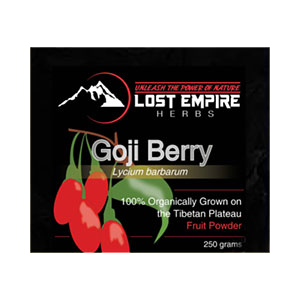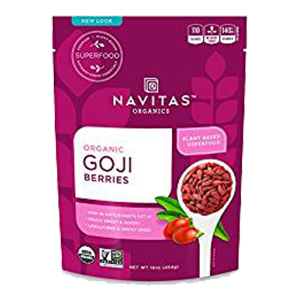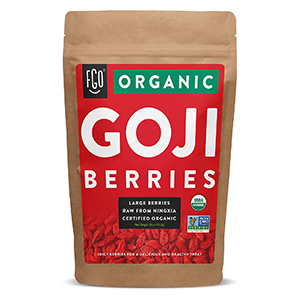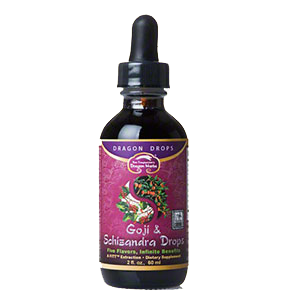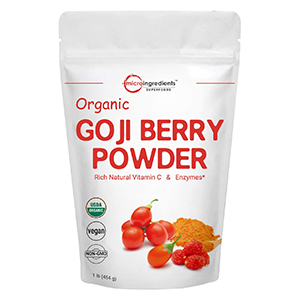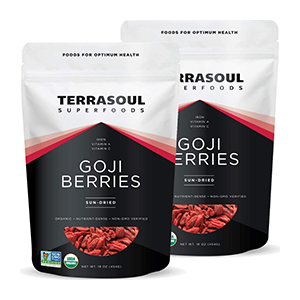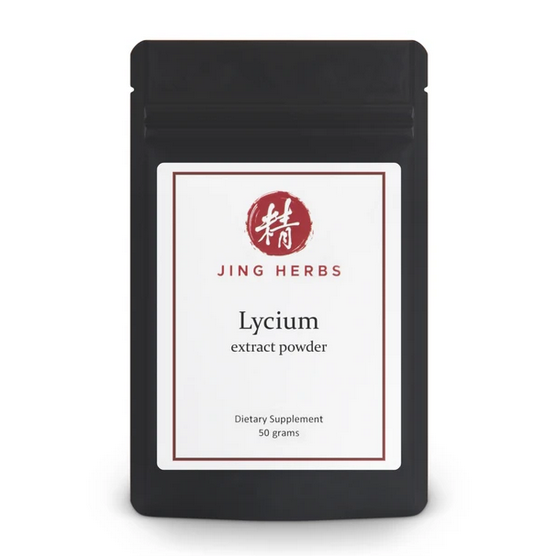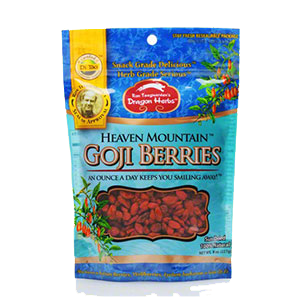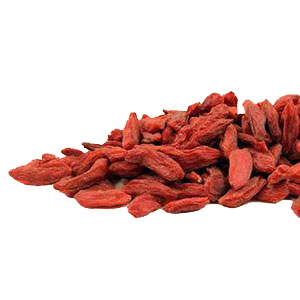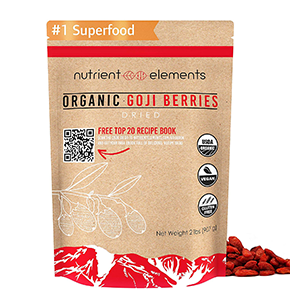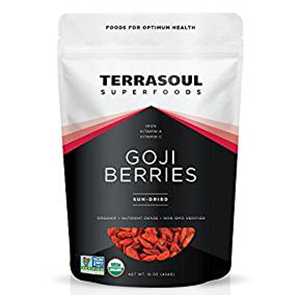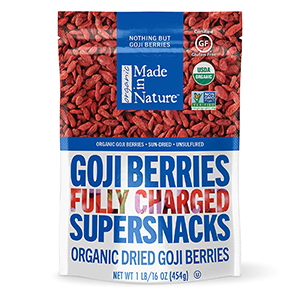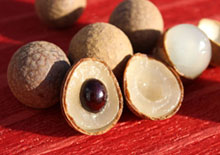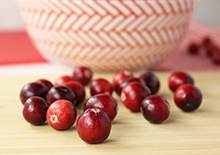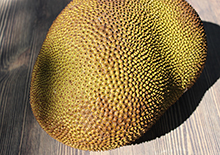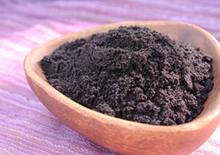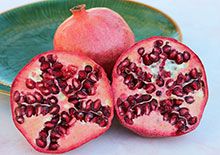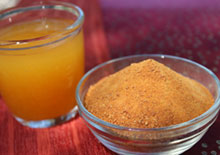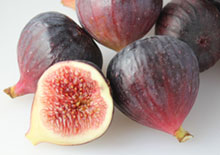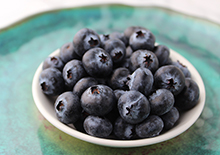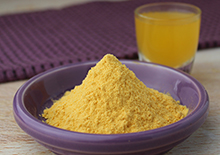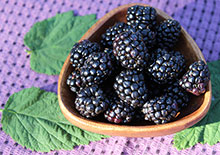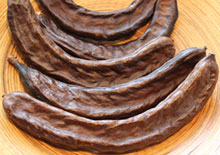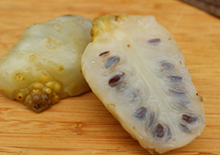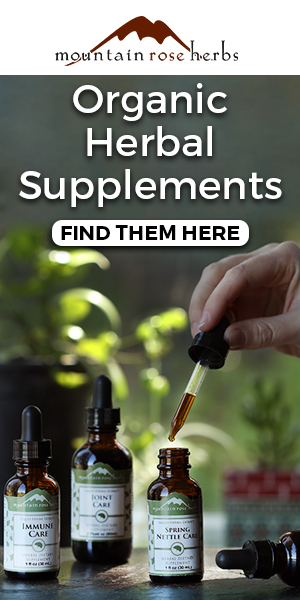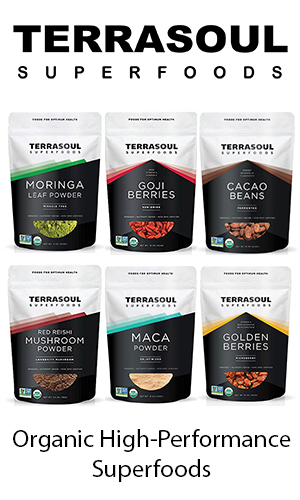- Home
- Super Fruits
- Goji Berries
Goji Berries, A Tonic Herb and Superfruit Variety
Intro | "Lycii" to "Goji | Goji Uses and Taste | What are Goji Berries? | Health Benefits | Types | How to Use | Precautions | Shop
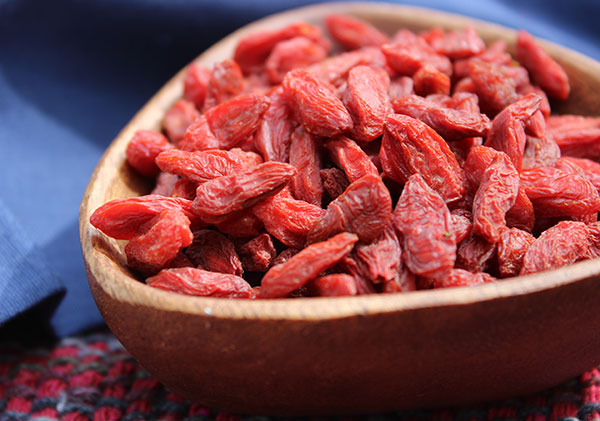
Goji berries are the red-orange fruits of certain Lycium species, highly revered as a major Chinese tonic herb for their blood building qualities and restorative effects on the liver, kidney and immune functions.
Commonly brewed for centuries as an herbal ingredient in numerous tea preparations, they are known for their ability to replenish Yin Jing essence, the primordial energy of the body associated with the kidney-adrenal system, sexual libido and fertility.
The fruit is consequently famous as a prized "longevity tonic" believed to encourage a healthy long life with prolonged use.
Table of Contents
Intro | "Lycii" to "Goji | Goji Uses and Taste | What are Goji Berries? | Health Benefits | Types | How to Use | Precautions | Shop
One of the greatest legends told throughout the Orient is of Chinese herbalist, Li Ching-Yuen, who became famous for his longevity and his routine use of tonic brews and tinctures consisting of ginseng, reishi gotu kola, he shou wu and goji berries.
Goji tea was also known to be consumed daily by China's "King of Medicine", Sun Simiao, as well as famous herbalist and Taoist master, Tao Hong-Jing.
From "Lycii" Berry to the "Goji" Berry
Although they have been utilized for more than 2000 years in Chinese herbalism, called gou qi zi, the berries were only recently introduced on a large scale to health-conscious communities worldwide in the early 2000's.
We first became familiar with the goji fruit, along with other major Chinese tonic herbs, in the mid 90's. Western herbalists back then referred to them as "lycii" berries. The now popular name "goji", to a large degree, came about when the fruit was extensively marketed as a superfruit variety.
Interestingly, according to the Tanduk Research Institute of Traditional Himalayan Medicine, the term "goji" technically originated in the Himalayan regions of Mongolia and Tibet, where it grows wild. (Source)
Goji Uses and Taste
Here in the Western U.S., gojis are now frequently consumed as dried berries, eaten like raisins or used in shakes and smoothies. While dried or reconstituted forms are considered quite nutritious, simmering the fruits in hot water, tea formulas, soups, stews or grains is traditionally believed to increase and release other beneficial nutrients.
The dried fruits have a chewy texture with a sweet and slightly salty flavor that tastes like a combination of cherries and raspberries. They are generally well tolerated by many different constitutions and body types.
Acting as both a tonic herb as well as energizing food source, it is one of our personal top 10 superfoods.
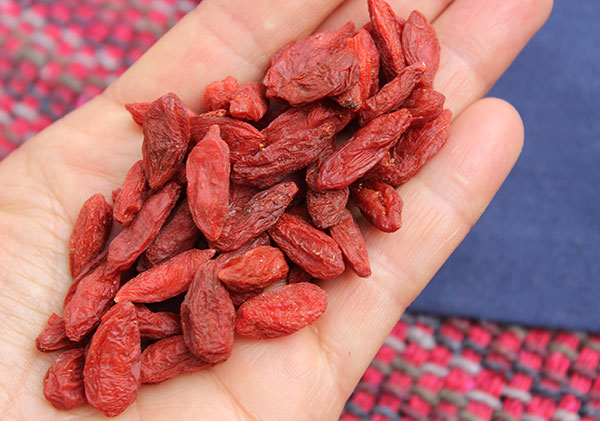
What are Goji Berries?
Goji berries come from the Lycium genus of over 50 different species. The primary one used in Chinese herbalism and sold as a dried superfruit is the Lycium barbarum variety. The two closely related species Lycium chinense and Lycium barbarum, both of which go by the Chinese name gou qi zi, are thought to be native to southeastern Europe and Asia.
Chinese lycium species have in the past often been referred to as lycium fruit, wolfberries or lycii (often pronounced lee-chee) berries, not as "goji" per say. Today, however, they are most commonly labeled and sold worldwide as "goji", mostly for marketing purposes.
L. barbarum, a slightly taller species, is the main variety cultivated in China for commercial export. They are primarily grown in regions of Ningxi, Xinjiang and Qinghai, but are also farmed in Shanxi and Gansu Provinces.
Other varieties also grow wild in many subtropical, temperate and arid desert-like climates around the world. These versions may produce different types of edible or inedible fruits or likewise may not bare any fruit at all.
Quite a few species from the genus Lycium, such as L. californicum, L. andersonii and L. fremontii, are found growing in the desert regions of the Southwestern U.S. and Mexico.
Lycium fruit was, in fact, a staple food source of several indigenous tribes located in these areas. According to the the book "Temalpakh: Cahuilla Indian Knowledge and Usage of Plants", the dried berries were "boiled into a mush or ground dried into a flour and mixed with water" and "were considered a significant item in the Cahuilla diet."
Goji berries also occasionally go by the name boxthorn or matrimony vine. Like ashwagandha and golden berry, all lycium species are members of the nightshade family, Solanaceae.
The actual goji berry plant itself is a vine growing species and woody deciduous perennial that grows an average height of 3-10 feet (1-3 meters), producing a purple flower and an oblong red-orange berry approximately 1/2-1 in (1–2 cm) in diameter.
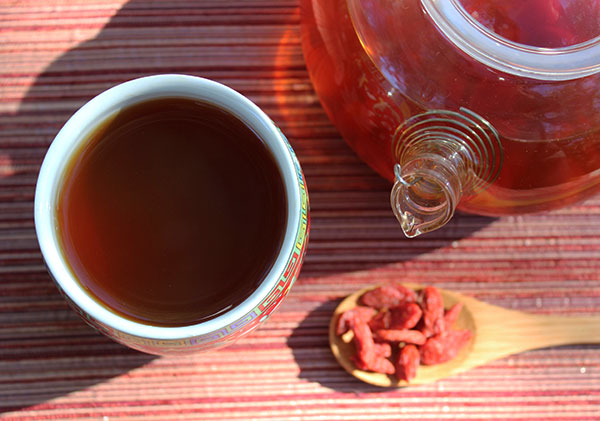
Goji Berries Benefits
1) Yin Jing Chinese Tonic
2) Immune Modulating Effects and LBPs
3) Helps to Increase Enzymatic Antioxidants
3) High Levels of Carotenoid Antioxidants
4) Renowned Beauty Tonic and Mood Enhancer
5) Protein and Other Nutrients
Yin Jing Chinese Tonic
Goji works on the 3 specific yin organs, primarily the kidneys and the liver, but also provides some benefits to the lungs.
In Chinese medicine gou qi zi, or lycii berries, are considered a major tonic herb for restoring Yin Jing and are specifically replenishing to kidney Yin, the store house for Jing or "vital life energies." They can be a nourishing decoction to use with other tonic herbs, like fo-ti and rehmannia, in cases of kidney Yin deficiency, often associated with kidney-adrenal burnout.
Yin herbs build depleted Jing energy and, as a result, are known to increase sexual libido and fertility, especially with prolonged use.
In earlier research published in the journal Life Sciences it was concluded that findings support the use of lycium fruit "as an aphrodisiac and fertility-facilitating agent" and provide scientific evidence that supports their use "as a traditional remedy for male infertility in China."
Other current studies also recognize the protective and rejuvenating effects of goji berry extracts on male testicular and erectile functions. (*)
Liver and Blood Tonic
Goji, with its high amount of iron, helps to build the blood, is good for anemic individuals and tonifying as well as detoxifying to the liver organ. Its added betaine content also serves to protect against toxins, elevated plasma homocysteine concentrations and fatty deposits in the liver organ.
Immune Modulating Effects and LBPs
Goji berries are an adaptogenic superfruit variety prized for their double-directional immune modulating influence on the body, helping to either increase or lower immune response when necessary.
Lycium barbarum Polysaccharides
Well researched for their high concentration of polysaccharides,
known as Lycium barbarum polysaccharides or LBPs, a published 2015
review indicates that "both preclinical and clinical studies support the
medicinal, therapeutic, and health-promoting effects of LBPs."
LBPs, offering significant immunological protection and antioxidant support, have
been shown to provide numerous pharmacological activities including
hepatoprotective, cardioprotective, neuroprotective and
anti-inflammatory attributes.
According to the previously mentioned
review analyzing LBPs it was mentioned that, "Many naturally occurring polysaccharides have been reported to
be potent immunomodulators. These polymers can influence innate and
cell-mediated immunity through interactions with T cells, monocytes,
macrophages, and polymorphonuclear lymphocytes. LBPs have been found to
have a variety of immune-modulatory activities in vitro and in vivo."
The Lycium barbarum polysaccharides in goji are additionally an energizing fuel source known to help regulate blood sugar, improve digestion and are customarily utilized in Chinese martial arts for their ability to strengthen the legs and increase flexibility in the joints.
These long chain sugars also work to detoxify the liver and bloodstream as well as fortify the immune system by providing a prebiotic food source for the "good bacteria" in the digestive tract.
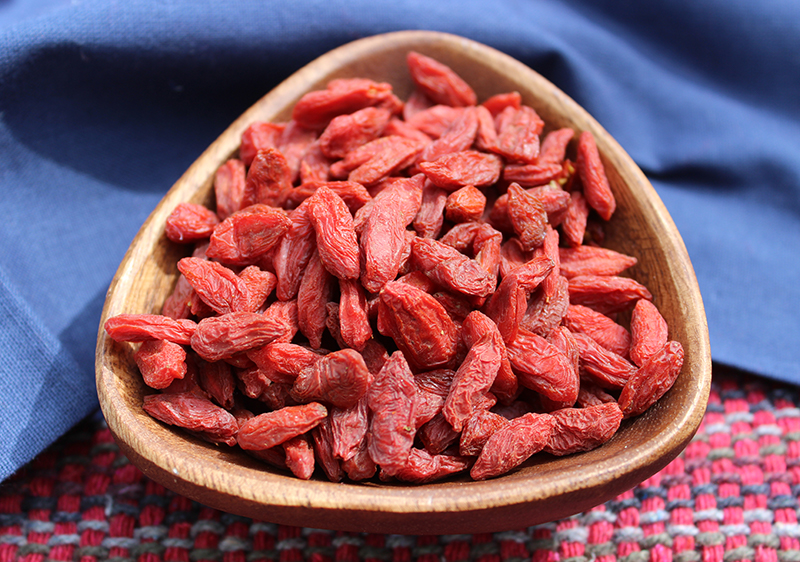
Helps to Increase Enzymatic Antioxidants
Enzymatic antioxidants are types of antioxidants produced by the body that help to protect against oxidation through a network of enzymes and their interaction with cells. They are activated by certain dietary nutrients but are most efficiently produced
within the body itself, rather than absorbed directly through food sources.
The LBPs in goji berry extracts have been shown to be effective in increasing the production of the enzymatic antioxidants: superoxide dismutase, catalase and glutathione peroxidase.
One study, reported in 2015, showed that higher dosages of LBPs given to mice for 4 weeks showed significant increases in SOD and catalase.
Superoxide dismutase, also called SOD, is a natural antioxidant enzyme produced within the body that plays a major role as a free radical scavenger, shields the body against DNA damage and also exhibits actions as an anti-inflammatory agent. Consuming goji, and its natural source of LBPs, has been shown to raise and support superoxide dismutase levels in the tissues and blood.
Glutathione is another master antioxidant found to some degree in all cells. It supports immune response and the function of the body's main detoxification pathways. Catalase shields our cells by counteracting and balancing the production of hydrogen peroxide.
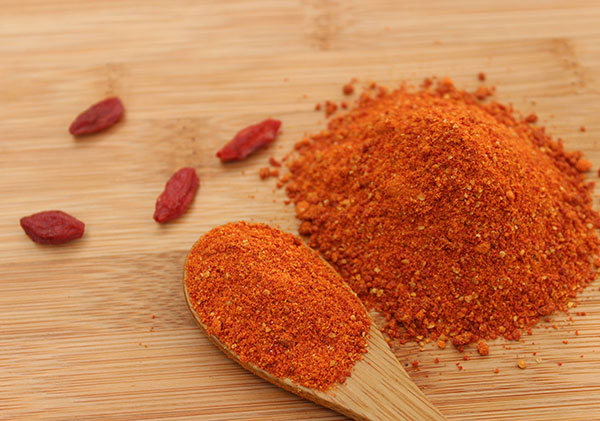
High Levels of Carotenoid Antioxidants
Goji berries are a nutritionally dense source of dietary antioxidants, like the carotenoids beta-carotene, zeaxanthin, lutein and lycopene.
Some research indicates that, "L. barbarum was found to accumulate high levels of carotenoids (primarily zeaxanthin)."
Zeaxanthin Content Supports Healthy Eyesight
Zeaxanthin, the predominant carotenoid found in goji, is an essential nutrient that helps to support healthy eyesight.
This corresponds with the commonly held belief in Chinese herbalism that goji helps to "brighten the eyes and improve vision."
They are traditionally used with schizandra berries, another excellent superberry for the eyes, or can likewise be consumed in drinks and smoothies with other antioxidant-rich superfoods.
In a study published in the British Journal of Nutrition analyzing the levels of zeaxanthin in goji fruit for those with age-related macular degeneration, it was concluded that human supplementation identified that the zeaxanthin content in the "whole berries is bioavailable" and that consuming a small daily amount "increases fasting plasma zeaxanthin levels" and that this data supports "dietary strategies to maintain macular pigment density."
Moreover, in a 2014 study it was also shown that the LBPs in the berries protect the cells and lens of the eye from oxidative stress and may be beneficial for those with cataracts.
While goji's, depending on source, can contain a small amount of vitamin C content, usually levels are relatively low compared to most other superfruits, like maqui, camu and golden berry.
Renowned Beauty Tonic and Mood Enhancer
Goji is highly revered as a beauty promoting tonic for its ability to nourish, not only kidney Yin deficiencies that are common as we grow older, but also for its benefits on blood purification and liver function which directly affect the health of our skin.
In addition, its high polysaccharide and antioxidant content helps to encourage collagen production and repair damaged tissue with moisturizing effects that are useful for preventing dryness and wrinkling.
As an adaptogen, lycii fruit also provides stress-reducing properties that help to "preserve youthful qualities." It is often incorporated into many Chinese beauty formulas for these reasons.
Regular consumption of this bright red-orange fruit is known to uplift the spirits and enhance one's mood.
Protein and Other Nutrients
Goji berries are known to contain higher amounts of protein compared to other fruits which are commonly quite low. Typically, a one ounce serving of goji contains between 3-4 grams of protein, consisting of 18 different amino acids.
They are also a rich source of iron with one ounce of berries containing between 10-14% RDA based on a 2000 calorie diet. In addition the same portion makes up about 28% the RDA for copper and 25% the RDA for selenium. Goji consists of other vitamins and minerals like vitamin C, B1, B2, calcium, zinc and riboflavin. (Source)
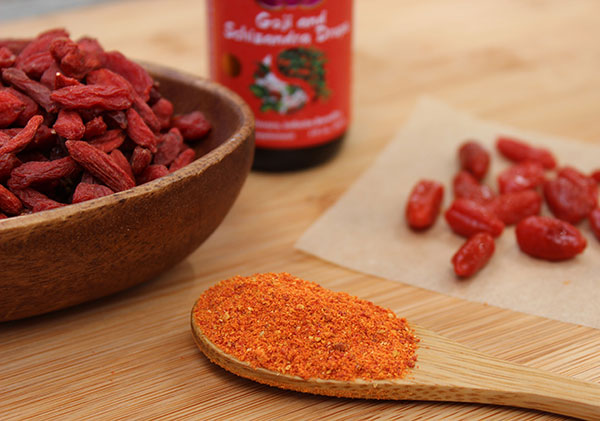
Types of Goji Berries
- Dried berries - These are whole dried berries, preferably low-temperature dried to preserve freshness.
- Powdered Goji - Most goji powders are created, like acai, by freeze-drying the berries and then processing into powdered form.
- Goji Berry Extracts - Lycium fruit can be concentrated as a powdered hot water extract or is likewise available as a liquid solution.
- Goji Berry Juice - Goji is a popular superfruit variety often available as a juice concentrate. It is best to purchase organic pure goji juices that contain no added sugar, artificial colors or artificial flavors.
- Fresh Berries - Harvested wild or cultivated berries can be consumed fresh or dried, juiced and added to drinks.
Why Quality is Important
As of 2016, most all goji berries sold worldwide are exported from China.
Gojis that are labeled "Tibetan" or "Himalayan" are actually a product of China, not Tibet as the name might imply. They are commonly grown in a region called the Tibetan Plateau, usually from the Qinghai province of China which borders Tibet. According to herbalist Ron Teeguarden, author of the book Chinese Tonic Herbs, "Goji berries are not cultivated in the Himalayas, they simply grow in the wild often in the most inaccessible places."
In 2009 several brands of organically certified Chinese goji were found to be contaminated with pesticide residues believed to come from neighboring fields or contaminated water sources used for irrigation purposes. Since this time, many reputable goji suppliers always do additional third-party lab testing to ensure the quality of their product.
Purchased dried goji berries should not be overly dry, hard, bleached or pale in color, but a brightly pigmented red-orange and somewhat soft with a chewy texture, like raisins. It is best, in our opinion, to buy low-temperature processed berries to preserve freshness and nutrient quality.
It is ultimately best to purchase berries that are additionally grown in a clean pollution-free environment to ensure as little contamination as possible. Since many areas of China are notorious for their high levels of environmental air pollutants and conventional pesticide use, many U.S. goji suppliers now advertise the specific location in which the berries were cultivated.
Superior brands usually come from more remote mountainous areas that are naturally watered by glacial melt, usually the regions of the Xinjiang or Qinghai Provinces.
For more than 700 years lycii berries have been traditionally farmed in the Ningxia Hui Autonomous Region of China. This is due to its prime growing conditions next to the Yellow River which provide fertile floodplains for cultivating crops like goji.
However, according to our research, because of unsound Chinese environmental policies and increasing toxic waste contamination in some parts of the Yellow River, organic goji's from this region should be thoroughly tested.
Growing Your Own Goji Berries
We always encourage growing your own superfoods and super herbs, like gotu kola, tulsi, moringa, golden berry, aloe and others as well as goji. Many of these species are very adaptable to a variety of different climate conditions and can be grown in numerous parts of the world besides their native habitat.
Goji's grow in climate zones 3 through 10 and are very hardy shrubs that have been known to endure hot to freezing temperatures.
Each of the raw dried berries contain between 10-60 small yellow seeds that can be planted to grow another goji plant. However, they are easiest to start as a shoot transplant rather than from seed.
They work well as a potted plant or garden species, either trellised or grown as a shrub variety. In the Northern Hemispheres, the berries will ripen from late summer to early fall.
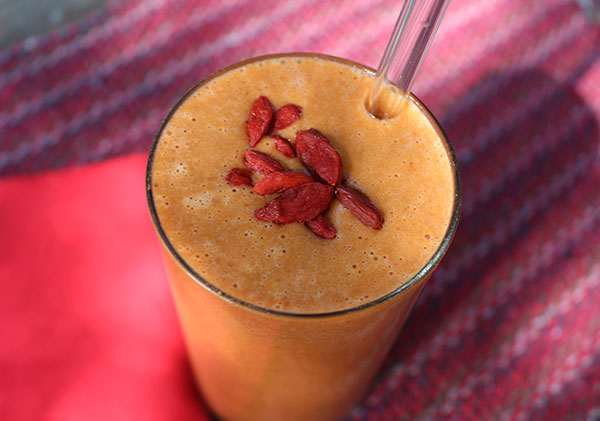
How to Use
Traditionally, lycii berries are decocted (simmered) in water to help release some of their beneficial polysaccharides. For centuries they have been incorporated into Chinese herbal formulations to help harmonize other herbs and increase their effectiveness. They are still frequently used today with other tonics, like reishi, ginseng, jujube, astragalus, he shou wu and especially schizandra. (See our energizing tea elixir recipe.)
They make a great addition to most herbal tea recipes and can likewise be incorporated into soups, stews and cooked grains, like rice, quinoa or oatmeal.
You can eat them dried, of course, by the handful like raisins and still retain many antioxidants and other nutrients. They taste like a cross between cherries and raspberries with a mostly sweet, but slightly salty taste. They are great in trail mixes with other berries, nuts or even cacao nibs.
The dried berries can also be added to smoothies, desserts and are actually a nice addition to homemade ferments like kimchi and kombucha. Often it is best to soak or reconstitute them for several minutes in water before blending them into foods and drinks.
Their higher protein content makes a great addition to a protein shake or homemade protein bars. We use them in our kale salad, goji berry lemonade, carrot cake, fire cider and superfood ice cream recipes.
Goji berries are also available as a ground freeze-dried powder, which is more convenient for some people. Or, they can be similarly ground as dried berries in a high speed blending device, but this produces a coarser fruit powder consistency.
Try goji berries in some of our recipes:
Precautions:
Goji berries are relatively safe to consume for a wide range of people, but should be avoided by those sensitive or allergic to foods from the nightshade family. We recommend that you consult with a qualified healthcare practitioner before consuming goji if you are pregnant, breast-feeding or taking prescribed medications, especially blood thinners.
Shop Related Products (About Affiliates & Amazon Associate Paid Links)
Affiliate Disclaimer: This section contains affiliate product links. If you make a purchase through our recommended links, we receive a small commission at no additional cost to you. Thanks for the support.

